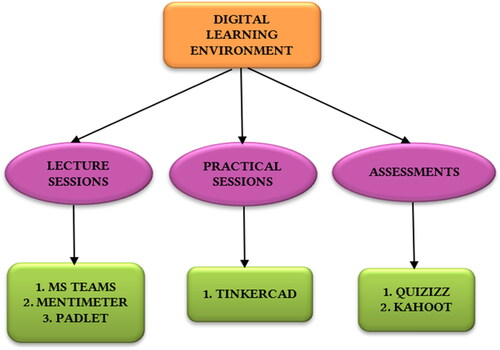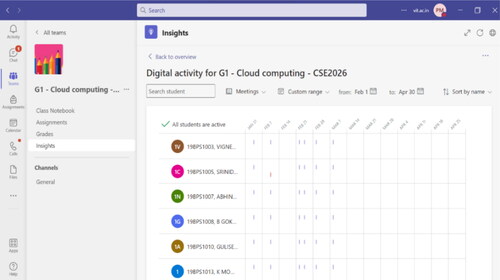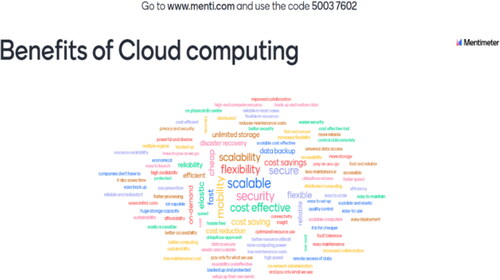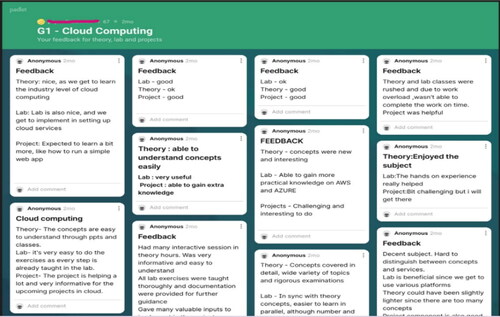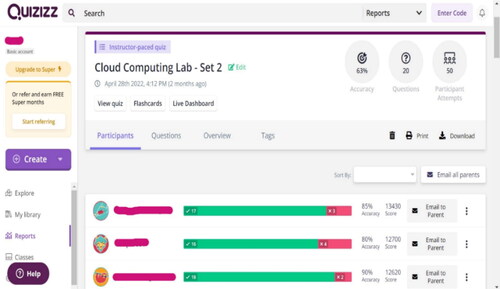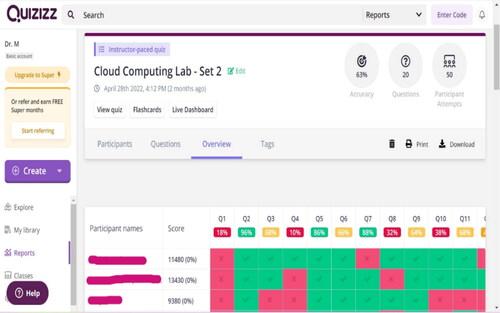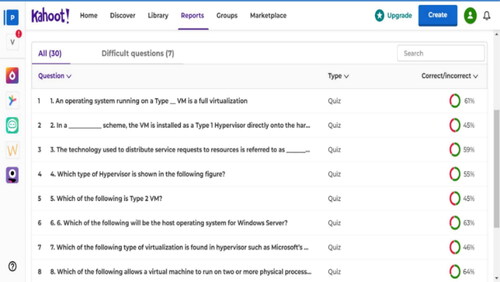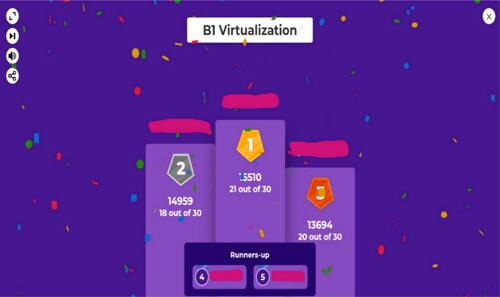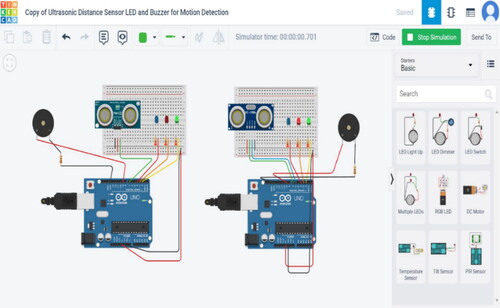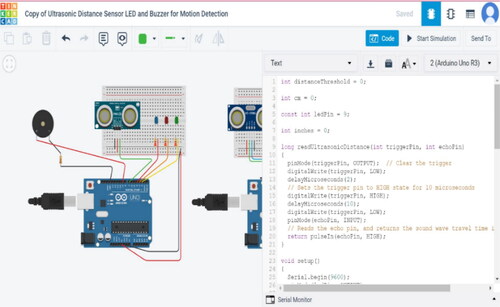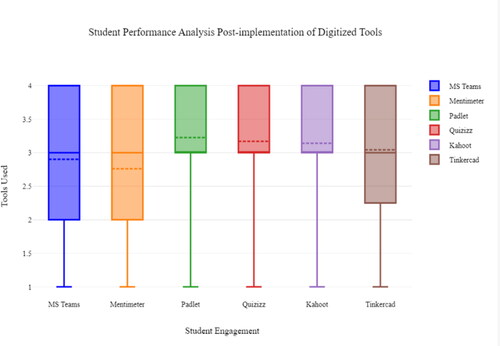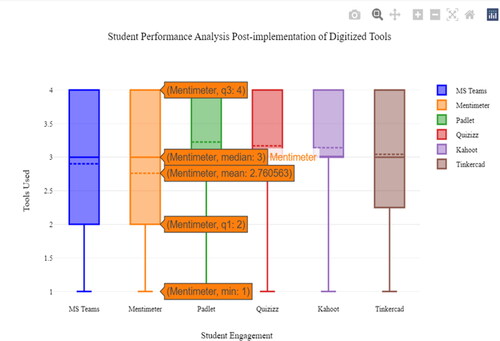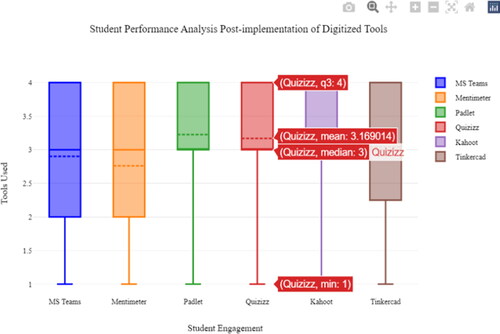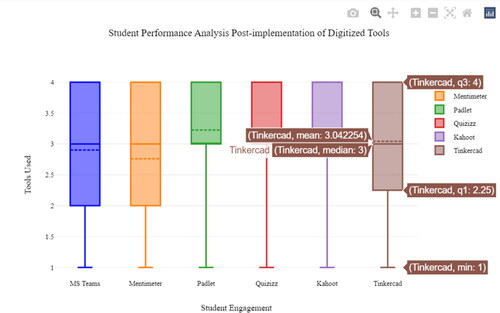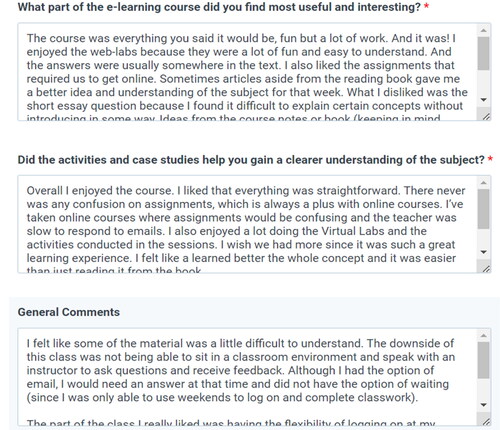Abstract
The integration of digital instructional methods has significantly enhanced the academic system. This study explores the viewpoints of educators and students on the application of digital resources and online platforms in the aftermath of the global health crisis. The research involved 135 university students enrolled in a cloud computing course that integrated theoretical teaching, practical exercises, and assessments to track their academic progress. Educational sessions were conducted on platforms like Microsoft Teams, Mentimeter, and Padlet, while interactive games were utilized on platforms such as Quizizz and Kahoot. Practical exercises were carried out using Tinkercad. At the end of the semester, the students’ academic performance was evaluated using box plots, and a detailed comparison between traditional and digital teaching methods was presented. Results indicated that the majority, approximately 75%, of the students demonstrated better performance when employing digital learning strategies compared to traditional methods. In addition, feedback was gathered through surveys to evaluate the effectiveness of the study, incorporating perspectives from both educators and students for a comprehensive assessment.
Reviewing Editor:
Introduction
The education sector has transitioned towards online educational platforms, offering boundless learning opportunities, particularly in the aftermath of the pandemic (Archee, Citation2022). This shift has elicited both favourable and adverse reactions from educators. A study was carried out involving interviews with teachers regarding their experiences with online teaching methods (El-Soussi, Citation2022). A prevalent sentiment among faculty members was the significant increase in time and effort required to prepare for online lectures compared to in-person sessions, along with a lack of face-to-face interactions and student motivation for attending virtual classes (García-Alberti et al., Citation2021). Some teachers expressed that their role now resembled that of a facilitator guiding the learning process rather than a traditional lecturer. The responses obtained were varied, underscoring the necessity for educators to undergo training in effectively utilizing online platforms. Another study focused on the advantages and drawbacks associated with the concept of “Working-from-home” (Almpanis & Joseph-Richard, Citation2022). This research highlighted the benefits of online education, such as video-based content and feedback, interactive assessments and assignments, and the use of diverse digital tools. Additionally, it provided educators with opportunities for professional growth and career advancement. In a separate investigation (Bhadri & Patil, Citation2022), live studios were utilized to create educational videos for deployment on Learning Management Systems (LMS). This approach showcased a blended learning strategy that integrates online and in-person instructional methods. The feedback from teachers indicated high levels of satisfaction (Kelling & Kelling, Citation2022) with the positive responses received from students. Despite the additional effort and time required for blending asynchronous and synchronous content delivery, educators were encouraged and content with this hybrid approach.
Role and impact of ICT in higher education
The importance of Information and Communication Technology (ICT) in higher education has significantly increased (Suleiman et al., Citation2020), transforming the delivery methods of education. ICT plays a vital role in providing access to resources that enhance the educational experience, promote interactive teaching methods for active learning, encourage collaboration and networking, and allow for personalized learning (Oliver, Citation2002) to cater to the needs of modern learners. Some other notable impacts of ICT on the education system include:
Improved learning outcomes and student engagement
Enhanced access to educational opportunities
Increased efficiency in administrative processes
Facilitation of lifelong learning and professional development
Acceleration of research and innovation
Expansion of global educational networks and collaborations
Addressing disparities in access and promoting inclusivity
Overall, ICT has transformed higher education, empowering students, educators, and institutions to embrace a digital learning environment, expand educational horizons, and explore new possibilities for teaching, learning, and research. Information and Communication Technology (ICT) has significantly influenced the landscape of higher education, bringing about transformative changes in the methods of teaching, learning, (Bindu, Citation2016) and administrative functions. The utilization of ICT has increased the availability of information and educational materials, enabled adaptable and tailored learning experiences, promoted collaboration and communication within academic communities, optimized administrative operations, expedited research and creativity, broadened international academic connections, and advocated for inclusivity. ICT has revolutionized higher education by empowering students, educators, and institutions to navigate a digital learning environment, enhance academic achievements, and extend educational accessibility on a worldwide basis.
However, the current situation has quickly replaced the traditional teaching model and required educators to innovate the teaching and learning process by incorporating interactive pedagogies to transform digital learning experiences. Although many educational institutions have already equipped themselves with technological resources such as smartboards, their utilization has been relatively limited. With a noticeable shift in the global teaching and learning landscape, instructors are now compelled to familiarize themselves with virtual labs (Liu et al., Citation2022) and tools, and integrate digital assignments and assessment techniques into their curricula. Following the implementation of such digital platforms, the effectiveness of the teaching methods can be assessed by monitoring the responses of learners.
In addition, this study has brought to light the diverse experiences of educators in incorporating various online tools and techniques into their routine classes. The primary objective of choosing the cloud computing course is to provide students with the necessary knowledge and capabilities required to utilize cloud computing technologies effectively to tackle engineering obstacles and improve efficiency across various fields. The theoretical portion of the course serves to familiarize students with the basic concepts and principles of cloud computing, covering topics such as cloud architecture, models, and services. Students will also develop an understanding of virtualization, scalability, elasticity, and resource pooling, which are fundamental attributes of cloud computing. The practical component of the course is centered around hands-on experience with cloud computing platforms and tools that pertain specifically to engineering disciplines. Upon completion of the course, students will have a strong theoretical groundwork in cloud computing principles along with practical expertise that enables them to efficiently apply cloud technologies within engineering settings. Tools such as Mentimeter, quizziz, Microsoft Teams, and Kahoot have been utilized to administer polls, quizzes, and regular lectures for students in this respective course.
Research gap
The following research gap has been identified and is addressed in the proposed teaching-learning methodology.
Lack of usage of interactive media in conventional classrooms.
Absence of content and educators in an asynchronous environment.
Lack of availability of productive content in different formats.
Effect of digitization on student’s performance is not signified.
Emphasizing the feedback from the learners to enrich the content delivered in the classroom is missing.
Absence of appropriate training in utilizing digital resources by both learners and educators.
Major objectives
The research has addressed the following objectives based on the experiences of educators post-implementation of digital tools in their traditional classrooms:
Integration of digital media and tools within regular classroom instruction.
Establishment of an asynchronous learning environment to ensure content and educators are accessible when needed.
Provision of hands-on experiences for both communities to acquaint themselves with digital technologies utilized in classrooms.
Examination of learner performance to gauge the impact of digital learning on knowledge acquisition.
Assessment and consideration of feedback from both learners and teachers to discern and meet the learning requirements of the students.
Literature review
The development of an engaging and adaptive learning environment that caters to the diverse needs of students has presented a significant challenge for educators. In many instances, teachers have struggled to incorporate innovative technologies into their daily teaching practices. A common issue cited is the lack of adequate training in utilizing these tools before the emergence of the pandemic (Calonge et al., Citation2022). This has led to difficulties for educators in adapting to new pedagogical methods. Some studies focusing on STEM education have indicated that instructors have exhibited positive attributes such as increased technological proficiency, enhanced self-efficacy (DeCoito & Estaiteyeh, Citation2022), and a willingness to integrate these strategies into their teaching practices. However, there remains a lingering reluctance towards embracing online learning approaches. Recommendations have been proposed to provide teachers with professional development opportunities, avenues for career advancement, and training to enhance their instructional techniques (Akram et al., Citation2022). Encouraging educators to utilize a variety of ICT tools and pedagogical approaches can help improve their teaching effectiveness.
One research endeavour showcased a wide range of teaching strategies implemented within the classroom setting, including short flipped videos, self-regulation techniques, creative activities, and digital assessments, among others, for delivering online and distance education (DeCoito & Estaiteyeh, Citation2022). However, the amalgamation of numerous techniques failed to engage learners and achieve desired learning outcomes effectively. Instructors expressed dissatisfaction with the online teaching methods employed in this study. Despite these challenges, there remains untapped potential in leveraging basic ICT tools (Ferede et al., Citation2022) for instructional purposes. Teachers have been hesitant to transition from traditional teaching methods to online learning environments. To enhance the efficacy of digital learning, educators should be empowered to select appropriate tools (Poudevigne et al., Citation2022) for their specific courses. The utilization of Open Educational Resources should also be encouraged (Maitra & Anurekha, Citation2021) to provide learners with greater flexibility in accessing learning materials at their convenience.
Once instructors have selected suitable techniques, strategies, and platforms tailored to their courses, designing instructional content becomes more streamlined. These tools and methods should be chosen to foster collaboration, facilitate open communication among peers and teachers, and ensure fairness and equity in the learning process. Prioritizing virtual lectures over theoretical frameworks and implementing online tools have proven beneficial (Ramya & Poongodi, Citation2021), particularly in laboratory sessions. For example, utilizing platforms like Blackboard Collaborate for virtualizing lab sessions in subjects like chemistry (Díez-Pascual & Jurado-Sánchez, Citation2022) has enabled undergraduate students to enhance their practical skills and actively participate in learning activities. Educators have played a crucial role in supporting student learning by providing timely feedback, evaluating student performance using rubrics, and promoting knowledge construction.
Moreover, the use of online platforms such as YouTube videos, social media sites like Facebook, and web-based content (Acharya, Citation2015) has been explored for teaching programming languages virtually. While some studies have shown partial success in integrating these platforms, many students have expressed the need for a more transparent grading system (Al Ahmad & Obeidallah, Citation2022) to ensure fairness in assessing their work. Additionally, research has demonstrated that students have performed well in remote and distance learning settings compared to synchronous modes of instruction (Aryal & Balan, Citation2022), particularly in courses like Information Systems. The integration of various Web 2.0 tools in arts and science courses has aimed to create a collaborative learning experience. However, faculty members have faced challenges in time management (Alsuwaida, 2022) and overcoming student resistance towards digital transformations. To address these issues, recommendations have been put forth to tailor activities based on student preferences and equip educators with the necessary training to effectively implement these strategies in relevant courses.
Comparing the educational landscape before and after the pandemic, many educators have shown support for the shift towards online learning. However, some instructors advocate for a blended teaching and learning approach (Saha et al., Citation2022), combining traditional and online strategies to achieve better outcomes post-pandemic.
ICT tools and software in education
The below table represents some of the existing ICT tools, their benefits and challenges incorporated in a digital learning environment.
Methodology
Sample
The educational institution has implemented a choice-based credit system, leading to 135 third-year computer science students selecting the cloud computing course. These students were taught by three faculty members from the Department of Computer Science and Engineering. Data on student performance was collected from the three classes, which utilized a combination of traditional and digital teaching methods for the cloud computing course.
To optimize the use of digital tools, a sample size of 135 students, overseen by three teachers, was selected for this study. This decision was made to ensure the effectiveness of the virtual learning environment and to prevent complications associated with handling a larger number of students. This sample size facilitated the smooth delivery of digital classes and allowed for effective monitoring of student performance in both traditional and digital learning settings.
Proposed architecture
The research carried out in this study highlights the integration of digital technologies and platforms in the educational process following the conclusion of the pandemic. The architectural design outlined in emphasizes three essential elements of an online classroom setting.
The elements comprising this set-up encompass engaging instructional presentations and hands-on activities paired with cooperative evaluations. The focus of this investigation lies in the curriculum of cloud computing designed for undergraduate students. This segment showcases the utilization and attributes of diverse tools and methodologies employed in the virtual pedagogical process for facilitating the course efficiently.
Methodology applied
The approach utilized in this research encompasses the incorporation of three distinct sets of ICT tools aimed at increasing student participation, encouraging interactive learning, facilitating practical learning experiences, and evaluating student advancement. These tools consist of MS Teams, Mentimeter, Padlet, Quizizz, Kahoot!, and Tinkercad within the standard classroom framework. The fundamental classroom arrangement employed in this study is outlined as follows.
Introduction to ICT Tools:
Students were acquainted with various ICT tools such as MS Teams, Mentimeter, Padlet, Kahoot!, Quizizz, and Tinkercad, and their significance in the digital educational environment.
Detailed guidance was given on the utilization of each tool and its relevant functionalities.
Delivery of Educational Content:
Interaction and Collaboration in Lecture Sessions:
An exclusive class group was established on MS Teams to facilitate communication, announcements, and academic discussions.
Students were prompted to utilize MS Teams for queries, resource sharing, and group collaborations.
Mentimeter was employed for interactive Q&A and brainstorming sessions during live lectures.
Implementation of Padlet was encouraged to gather feedback from the students.
Virtual Laboratories and Design Projects:
Tinkercad was introduced as a virtual design platform for engineering projects and practical learning experiences.
Design assignments or lab simulations were assigned using Tinkercad to reinforce engineering principles and foster problem-solving abilities.
Students were guided through tutorials or given design challenges to complete using Tinkercad’s 3D modelling and simulation capabilities.
These tools enabled students to apply their knowledge, creativity, and problem-solving skills in real-world engineering scenarios. Following the integration of these tools in the classroom, assessments were conducted periodically (term-wise evaluations) and after the semester.
Evaluation and Assessment:
A blend of traditional evaluations and data from ICT tools was used to assess student performance and advancement.
Interactive Assessment:
Quizizz was utilized to create engaging quizzes aligned with the complex subject matter taught in class.
Digital assessments (pre-reading or post-lecture tests) were designed using Kahoot! to gauge understanding and enhance learning.
The gamified aspects of these tools promoted student engagement and provided immediate feedback on their progress.
Support and Feedback for Instructors:
On completion of the semester, students were encouraged to share their feedback on their experiences with the tools, including suggestions for enhancements or additional features.
Both faculty and student perspectives were assessed to evaluate the efficacy of the methodology employed and make any necessary adjustments.
Tools used for lecture sessions: Microsoft Teams, mentimeter and padlet
Microsoft Teams
The utilization of the MS Teams platform presented a valuable opportunity to effectively collaborate, engage in discussions, and engage with students in an online setting. The inclusion of various integrated applications, such as the whiteboard for simultaneous work, options for monitoring learner progress, and tools for generating quizzes and enhancing creative learning, contributed to an enjoyable and seamless experience for all parties involved.
Productive features offered by the platform encompass the ability to schedule both instant and future meetings, assign digital tasks with corresponding deadlines (Ustinova et al., Citation2021), and provide rubrics tailored to these assignments. Additionally, an insightful feature (Hope et al., Citation2022) as depicted in , allows for the monitoring of learner activity within the platform.
The students found certain features to be particularly valuable, such as the organization of learning materials in a dedicated folder, online video conferencing (Dolenc et al., Citation2022), discussion forums, open collaboration space (Nawi & Hamidaton, Citation2022), and the ability to view their grades. The use of Flipgrid allowed for video feedback and discussions, while concept mapping through the MindMup feature of MS Teams encouraged visually appealing presentations of ideas.
Various other educational tools like whiteboards (Mendez et al., Citation2022), lucidchart, Loops for creative learning, and draw.io for creating architectures and flowcharts proved to be beneficial for both teachers and students. Due to its provision of essential resources for creating a conducive learning environment, most faculty members embraced this platform. Overall, the integration of this tool led to a well-coordinated teaching and learning experience.
Mentimeter
Mentimeter was employed to initiate a live poll within a traditional classroom setting. By incorporating a combination of multiple-choice queries and brief questions, as illustrated in , amidst the lecture sessions, educators were able to cultivate an enjoyable learning environment and sustain the participation of students over an extended period.
The visual representation of a word cloud, as shown in , facilitated seamless communication where all participants were able to share their ideas cohesively. The vibrant colours used in the display captured the attention of the learners, ensuring their engagement throughout the presentation. Particularly beneficial for shy or reserved students, this tool provided a platform for them to express their thoughts and opinions without revealing their identities.
The inclusion of personalized and interactive presentation capabilities further enriched the educational experience, offering a dynamic platform for delivering lectures with precision and engagement (Madiseh et al., Citation2022).
Padlet
Padlet is considered one of the most effective tools for facilitating rapid collaboration within the academic community (Chen, Citation2022). This platform is widely utilized to showcase the thoughts and insights of students on a virtual canvas. Each student’s contributions can be personalized through a variety of media and colour selections, allowing instructors to easily visualize and analyze the collective feedback and ideas shared by students in a visually appealing manner.
Within the realm of cloud computing education, padlet was specifically employed to aggregate and display collaborative digital feedback from students, as illustrated in . Students were encouraged to provide anonymous reflections on their experiences during both theoretical and practical sessions, granting them a sense of autonomy in sharing their perspectives.
Tools used for assessments: Quizizz and kahoot!
Quizizz
The effectiveness of any educational method or teaching approach in a classroom setting is contingent upon the level of engagement and enjoyment experienced by the learners. According to Yong and Rudolph (Citation2022), tools such as quizizz have proven beneficial for educators in creating dynamic and interactive classroom sessions, resulting in increased student involvement.
The utilization of quizizz, as outlined in , was specifically employed for the administration of brief quizzes as formative assessments and as part of comprehensive laboratory examinations. The data presented in this figure illustrates the total number of students who engaged in the quiz activity, as well as the individual progress of each participant in terms of correct responses provided. Furthermore, this platform offers the flexibility to implement either real-time or instructor-paced quizzes.
After the learner completed the quiz, their total scores, the proportion of correct responses and the accuracy of the quiz were showcased on the dashboard as shown in . This comprehensive summary of the quiz allowed facilitators to gain deeper insights into a learner’s development.
Kahoot!
Similar to Quizizz, Kahoot provides a gaming experience for learners (Che-Yahya et al., Citation2022). This platform allows students to participate in games either in groups or individually. Additionally, educators can develop question banks for their courses, facilitating the creation of quizzes in the future. The presence of diverse templates for crafting questions is an asset for teachers ().
Educators have found that student engagement and interactive learning have been enhanced. The implementation of a leaderboard, as depicted in , has encouraged students to strive for excellence, thereby fostering a more competitive educational setting.
Tools used for laboratory: Tinkercad
Tinkercad
This intriguing instrument was utilized for practical simulations during laboratory sessions. Students were able to enhance their skills and capabilities through hands-on experience (Velaora et al., Citation2022) provided by this tool. Utilizing the automated simulation feature depicted in , students could independently develop circuits, designs, and codes. The auto-generation of associated programs for circuits and designs streamlines the instructor’s responsibilities. The interactive editor included in this tool proves beneficial for facilitators in effectively showcasing live connections within circuits to students.
The learners were provided with the opportunity to connect, reconnect, design, and redesign circuits and blocks of code as necessary. The editable code view displayed in for the circuit connection played a crucial role in facilitating the student’s learning and exploration of the fundamental principles of circuitry.
In conclusion, the integration of these digital tools in the cloud computing course significantly enhanced the students’ proficiency in their academic pursuits and yielded favourable outcomes for educators.
Instrument
The assessment tool utilized in this research comprises two distinct questionnaires developed to assess the quality of the course delivered on the digital platform and to document the various experiences of both learners and facilitators. The questionnaire designed for students, as presented in , includes 8 items addressing the course quality and the learners’ perception of the knowledge acquired. Questions Q1 – Q4 focus on course quality and knowledge perception, while Q5 to Q8 assess the instructor’s involvement and the overall digital learning experience in the cloud computing course.
Table 1. Overall student response ratings.
All 135 second-year engineering students were required to rate each item on a scale from strongly agree to strongly disagree, and average ratings were subsequently calculated for each item. Similarly, the facilitator questionnaire, as depicted in , consists of 8 questions. Questions Q1, Q3, and Q5 pertain to the design of a curriculum, achievement of learning outcomes, and knowledge enhancement by the instructors. Questions Q6 – Q8 evaluate the impact of teaching on learner knowledge, while Q2 and Q4 assess the facilitators’ proficiency in utilizing digital tools. The responses from three facilitators were rated, and the averages for each response were calculated.
Table 2. Overall, teacher ratings.
In addition to capturing these responses, a comparative analysis of learner performance in digital and traditional classrooms was conducted to determine the most effective learning method for the students.
Design
An analysis was conducted on the learners’ scores before and after the integration of digital tools. The data was visually displayed using box plots to provide a comprehensive comparison of the learners’ performance. Furthermore, the effectiveness of each digital tool in the cloud computing course was evaluated to determine the most suitable tool for enhancing learner engagement in an online setting.
Results
This section provides a comprehensive overview of the evaluations and achievements of the students across the various digital tools previously explored. Visual representations are utilized to effectively display the comparative analysis of both the instructional methods utilized and the students’ performance when utilizing the different tools.
Performance evaluation on digital platforms
In , the performance of students using each digital tool in the study is illustrated.
The diagram above illustrates that the whiskers for MS teams, Mentimeter, and Tinkercad are noticeably more condensed in comparison to the other three tools, indicating a more consistent level of performance from learners using these tools as opposed to Padlet, Quizziz, and Kahoot. Conversely, the shorter whiskers of Padlet, Quizziz, and Kahoot suggest that learners using these tools exhibited poorer performance when compared to the three tools.
Furthermore, a detailed analysis of each tool was conducted to evaluate the proficiency of learners in each digital platform. For example, individual data for Mentimeter, Quizziz, and Tinkercad is presented in respectively, to emphasize the performance of learners using each of these tools.
The data presented in indicates that the median score for utilizing the Mentimeter tool is 3, revealing that approximately half of the results fell within the range of 3 to 4, with 3 being the highest score possible. Moreover, the q1 value of 2 suggests that 75% of learners achieved scores above 2 when using Mentimeter in the classroom, indicating a consistent performance range between the scores of 2 to 4.
Analogous analysis was conducted for quizziz and Tinkercad, as illustrated in and . However, for quizziz, the extended lower whisker signifies that a significant number of learners performed inadequately, with scores ranging between 1 and 3, unlike the results observed with Mentimeter. Furthermore, the q3 value of 4 indicates that only 25% of scores reached the maximum value of 4.
In the situation of Tinkercad, as illustrated in , it can be observed that while the median value is positioned at 3, similar to Mentimeter, the q1 value of 2.25 indicates that 75% of the students achieved scores higher than 2.25, distinguishing it from the other tools referenced earlier. Consequently, these evaluations suggest that the digital tools utilized in this study had a beneficial influence on the student’s engagement, achievement, and outlook, as the majority of their scores exceeded average levels in nearly all instances.
Student and staff reflections on the digital course
Reflections from both students and staff members regarding the digital course were gathered to assess the overall impact and effectiveness of the online classes. Feedback from participants was collected through a comprehensive questionnaire, which included ratings and comments related to their use of digital tools in interactive learning environments. The data collected from learners’ responses were tabulated in to evaluate the overall ratings given to different components of the online course.
The aforementioned ratings reflect the favourable results achieved concerning the online digital course. Specifically, the availability of the instructor as indicated in Q5 (100%), the effectiveness of the assignments provided in Q7 (83.4%), the engagement level of the sessions depicted in Q8 (87.1%), and the learning pace outlined in Q6 (78.64%) were key factors that influenced the learners’ interest in this course. Nevertheless, there is room for improvement in the aspects covered in Q1 to Q4 to meet the expectations of the learning community.
Additionally, participants were invited to share their overall feedback, as shown in , regarding the strengths and weaknesses they encountered during the cloud computing digital course.
The feedback received from the learners reflects a favourable outlook and constructive approach towards the integration of digital technology in educational courses. Conversely, the feedback received from the educators contradicted the learners’ perspectives in terms of the time and effort needed to establish a dynamic learning environment.
Despite this disparity, the facilitators expressed contentment in supporting the learners, fostering an interactive and learner-centered classroom environment, and embracing innovative technologies. The ratings gathered from the teacher surveys are outlined in .
About the aforementioned ratings, it is evident that the instructors overwhelmingly supported the positive aspects of digitizing the course, as the average response rate was 85.65% following the completion of the semester. Most educators have expressed their agreement on the importance of working together to establish a student-centered learning environment, as indicated in Q7 (87.8%). Furthermore, significant improvements were observed in terms of developing a practical and applicable theoretical curriculum, as noted in Q2 (88.4%), allowing for exploration of digital media in Q4 (94.6%), and offering support to struggling students as outlined in Q6 (85.7%).
Nevertheless, a small percentage of teachers (1.89% and 1.06%) have also acknowledged the challenges they face in meeting course objectives. These obstacles could be mitigated through additional, targeted training for educators on utilizing digital tools effectively and creating interactive learning experiences for students in their respective classes.
Findings
The comprehensive analysis of the student’s academic results depicted in the following indicates that the scores in the digital learning setting exhibit greater stability in comparison to the traditional learning environment. This discrepancy can be attributed to the presence of extended whiskers in the lower portion of the box plot for the traditional learning environment.
The extended lower whiskers indicate a higher proportion of students performing below average in a traditional classroom compared to a digital setting. Furthermore, the data illustrated in highlights the variance in student performance between the two educational methods utilized.
Table 3. Data interpretation of .
In the digital environment, the q1 value of 17 signifies that 75% of students scored higher than 17, whereas in the traditional setting, the q1 value is only 11, significantly lower than 17. Similarly, the q3 value in the conventional method shows that approximately 25% of students scored between 21.5 and 26, while in the digital environment, only 25% scored between 20 and 22.
Based on the data provided in , it can be inferred that the range of scores achieved by students in the digital learning environment is more consistent compared to the traditional teaching method. Additionally, the mean score displayed in the table suggests that students perform better in a digital learning environment than in a traditional classroom.
Discussion
The incorporation of ICT tools and software in an educational setting has numerous advantages. Initially, it broadens student access to a wide range of educational resources and information, empowering them to delve into various learning materials and partake in self-directed learning. ICT tools also support interactive and collaborative learning opportunities (Fu, Citation2013), enabling students to engage in online discussions, virtual group projects, and peer-to-peer knowledge exchange (Tochukwu & Hocanin, Citation2017). Moreover, ICT encourages personalized learning by adjusting content and activities to meet individual student needs (Koech & Wanjiku, Citation2022), creating a more customized and immersive educational experience. It also simplifies administrative responsibilities, such as grading and course management, enhancing efficiency and allowing educators more time to concentrate on teaching. Additionally, ICT provides avenues for remote learning, granting students access to education from a distance (Noor-Ul-Amin, Citation2013) and promoting continuous learning. Nevertheless, there are limitations associated with the integration of ICT tools and software in an educational setting. A notable obstacle is the existence of a digital gap, wherein certain students lack access to technology or reliable internet connections, resulting in disparities in educational opportunities. Moreover, the reliance on ICT could potentially lead to a decline in face-to-face interactions and hinder the development of social skills (Pandolfini, Citation2016). Technical glitches or overreliance on technology may disrupt the learning process in cases where systems or networks experience failures (Ghavifekr et al., Citation2016). Furthermore, the constant requirement for training and upgrading ICT competencies can be challenging for both teachers and students. Lastly, concerns about data privacy and security surface when utilizing online platforms, underscoring the importance of safeguarding sensitive information through cautious management. In general, although ICT tools and software provide many advantages in educational settings, it is crucial to acknowledge and tackle the accompanying hurdles to guarantee fair access, foster well-rounded learning opportunities, and uphold confidentiality and security of information.
The future perspectives for studying the integration of ICT tools and software in the engineering education setting are quite promising. As technology continues to rapidly progress, there is an increasing need for engineers who are skilled in utilizing ICT tools and software to solve intricate problems and foster innovation. This study highlights that the incorporation of virtual reality (VR), augmented reality (AR), and simulation software into engineering curricula will offer immersive and interactive learning opportunities, giving students the ability to visualize and manipulate complicated concepts. Furthermore, the utilization of collaborative platforms and cloud-based tools will allow students to collaborate on engineering projects regardless of their physical locations. Moreover, the advent of artificial intelligence (AI) and machine learning (ML) technologies will amplify the capabilities of ICT tools in engineering education, facilitating intelligent tutoring systems, tailored learning paths, and insightful feedback mechanisms. Embracing these upcoming perspectives will equip engineering students with the skills and abilities necessary to excel in a technology-centric world.
Conclusion
Educators with extensive experience struggled with integrating technological tools into their instructional practices, as they had traditionally favoured the traditional teaching method through direct communication and chalkboard presentations. The transition to online classes revealed challenges such as limited student interaction and a lack of engagement, leading to feelings of disappointment and reluctance among these instructors to embrace digital platforms for teaching fully.
Conversely, a different group of teachers found these tools to be efficient and conducive to engaging students in interactive and stimulating sessions. The availability of built-in features for monitoring student progress and participation proved beneficial, with learners expressing interest in various online teaching methods. Some educators noted that the utilization of online resources such as video lectures, interactive slides, and e-content contributed to improved learning retention rates among their students (Sharma, Citation2014).
Upon comparison of the diverse experiences of educators, the transformative impact of these pedagogical innovations on modern education becomes evident. Teachers increasingly appreciate the advantages of incorporating advanced technologies in their classrooms, recognizing the value of staying current and adaptable in their instructional practices. The flexibility and efficiency offered by digital resources enable educators to create reusable materials, save energy, and enhance the overall educational experience.
Nonetheless, it is essential to acknowledge that while technological advancements enhance teaching and learning processes, they cannot replace the indispensable role of a skilled educator. The physical presence of a teacher in a classroom is vital for understanding student behaviour, attitudes, and learning styles, as well as providing direct feedback and opportunities for physical engagement and interactive exercises, elements that are often absent in online learning environments.
Therefore, despite the numerous advantages of utilizing innovative digital tools in education, online learning cannot entirely replace traditional classroom settings. A blended approach incorporating both modern and traditional teaching strategies is recommended to optimize the learning experience for both students and teachers alike.
Author’s contribution
Ms. Monica Maiti has consolidated the results of the work performed and written the original draft. She has also reviewed, edited, and conceptualised the work. Dr. M. Priyaadharshini applied the tools in the classroom and supervised the work.
This work is mainly performed to gain insight into the viewpoints and obstacles encountered by learners and instructors alike, it is feasible to implement essential enhancements and modifications to the integration of ICT in education. This has the potential to enhance the efficiency and efficacy of technology utilization in educational settings, culminating in enhanced academic achievements for students. Furthermore, assessing experiences can pinpoint deficiencies and opportunities for enhancement within the existing educational framework, thereby paving the way for possible reforms and progressions. In essence, this process can play a significant role in fostering a more prosperous and all-encompassing educational environment for all parties involved.
Disclosure statement
No potential conflict of interest was reported by the author(s).
Additional information
Notes on contributors

Monica Maiti
Monica Maiti obtained both her Bachelor’s and Master’s degrees in Computer Science and Engineering from Saveetha Engineering College, affiliated with Anna University, located in Chennai, Tamil Nadu, India, in the years 2013 and 2015, respectively. Her primary academic focus lies in Technology-enhanced learning and Engineering Education.
She has work experience of 7 years as an Assistant Professor in the Department of Computer Science and Engineering at Saveetha Engineering College and VIT University, Chennai. Presently, she is engaged in her PhD at the latter. Her past research endeavours revolved around web technology, object-oriented programming, and data structures. Yet, she currently directs her efforts towards E-Learning, Learning Analytics, and cutting-edge educational technologies of the current century. Ms. Maiti’s distinction as an 'Engineering Educator’ has been certified by the IIEECP- IUCEE consortium and she also contributes as a peer reviewer for the EAIT journals.
M. Priyaadharshini
Dr. M. Priyaadharshini has 14 years of teaching experience in the computer science department. Ms.Priyaa is working as an Associate Professor (Sr.) in the School of Computing Science and Engineering (SCOPE) at Vellore Institute of Technology (VIT) University Chennai, India. She has completed B.Tech in Information Technology and M.E in Computer Science and Engineering from Anna University. She completed her Ph.D. in the field of Education Technology. Her research interests are Education Technology, Learning Analytics, Gamification, Flipped Classrooms, Augmented Reality, Virtual Reality, Internet of Things (IoT), and Cloud Computing. She also published research work in reputed journals and book chapters. Ms.Priyaadharshini is also a certified AWS Cloud Practitioner and certified Microsoft Innovative Educator
References
- Acharya, C. P. (2015). Use of ICT/web tools in ELT in Nepal. Journal of NELTA, 19(1–2), 1–16. https://doi.org/10.3126/nelta.v18i1-2.10326
- Akram, H., Abdelrady, A. H., Al-Adwan, A. S., & Ramzan, M. (2022). Teachers’ perceptions of technology integration in teaching-learning practices: A systematic review. Frontiers in Psychology, 13, 920317. https://doi.org/10.3389/fpsyg.2022.920317
- Al Ahmad, A., & Obeidallah, R. (2022). Studying the effectiveness of a proposed methodology for teaching programming labs online and students" perspectives toward it during COVID-19: A case study of Hashemite University. iJIM, 16(5), 53.
- Almpanis, T., & Joseph-Richard, P. (2022). Lecturing from home: Exploring academics’ experiences of remote teaching during a pandemic. International Journal of Educational Research Open, 3, 100133. https://doi.org/10.1016/j.ijedro.2022.100133
- Archee, R. (2022, February 2022). The future of teaching and learning in higher education in the coronavirus era [Paper presentation]. 5th International Conference on Future of Teaching and Education, Rotterdam, Netherlands.
- Aryal, A., & Balan, S. (2022). Evaluation of a technical information systems module for distance learning during the COVID-19 pandemic. Journal of Research in Innovative Teaching & Learning, 16(1), 53–66. https://doi.org/10.1108/JRIT-11-2021-0078
- Bhadri, G. N., & Patil, L. R. (2022). Blended learning: An effective approach for online teaching and learning. Journal of Engineering Education Transformations, 35(is1), 53–60. https://doi.org/10.16920/jeet/2022/v35is1/22008
- Bindu, C. N. (2016). Impact of ICT on teaching and learning: A literature review. International Journal of Management and Commerce Innovations, 4(1), 24–31.
- Calonge, D. S., Hultberg, P., Connor, M., Shah, M. A., & Aguerrebere, P. M. (2022). A retrospective snapshot of academic staff preparation at the onset of COVID. International Journal of Modern Education Studies, 6(1). https://doi.org/10.51383/ijonmes.2022.172
- Chen, Y. M. (2022). Understanding foreign language learners’ perceptions of teachers’ practice with educational technology with specific reference to Kahoot! and Padlet: A case from China. Education and Information Technologies, 27(2), 1439–1465. https://doi.org/10.1007/s10639-021-10649-2
- Che-Yahya, N., Alyasa-Gan, S. S., & Mohd, I. H. (2022). Classroom engagement using online games for financial course students. Korea Review of International Studies, 15(4).
- DeCoito, I., & Estaiteyeh, M. (2022). Online teaching during the COVID-19 pandemic: exploring science/STEM teachers’ curriculum and assessment practices in Canada. Disciplinary and Interdisciplinary Science Education Research, 4(1), 8. https://doi.org/10.1186/s43031-022-00048-z
- DeCoito, I., & Estaiteyeh, M. (2022). Transitioning to online teaching during the COVID-19 pandemic: An exploration of STEM teachers’ views, successes, and challenges. Journal of Science Education and Technology, 31(3), 340–356. https://doi.org/10.1007/s10956-022-09958-z
- Díez-Pascual, A. M., & Jurado-Sánchez, B. (2022). Remote teaching of chemistry laboratory courses during COVID-19. Journal of Chemical Education, 99(5), 1913–1922. https://doi.org/10.1021/acs.jchemed.2c00022
- Dolenc, K., Šorgo, A., & Ploj-Virtič, M. (2022). Perspectives on lessons from the COVID-19 outbreak for post-pandemic higher education: Continuance intention model of forced online distance teaching. European Journal of Educational Research, 11, 163–177. https://doi.org/10.12973/eu-jer.11.1.163
- El-Soussi, A. (2022). The shift from face-to-face to online teaching due to COVID-19: Its impact on higher education faculty’s professional identity. International Journal of Educational Research Open, 3, 100139. https://doi.org/10.1016/j.ijedro.2022.100139
- Ferede, B., Elen, J., Van Petegem, W., Hunde, A. B., & Goeman, K. (2022). Instructors’ educational ICT use in higher education in developing countries: evidence from three Ethiopian Universities. Journal of Computing in Higher Education, 34(3), 658–678. https://doi.org/10.1007/s12528-022-09316-3
- Fu, J. (2013). Complexity of ICT in education: A critical literature review and its implications. International Journal of Education and Development Using ICT, 9(1), 112–125.
- García-Alberti, M., Suárez, F., Chiyón, I., & Mosquera Feijoo, J. C. (2021). Challenges and experiences of online evaluation in courses of civil engineering during the lockdown learning due to the COVID-19 pandemic. Education Sciences, 11(2), 59. https://doi.org/10.3390/educsci11020059
- Ghavifekr, S., Kunjappan, T., Ramasamy, L., & Anthony, A. (2016). Teaching and learning with ICT tools: Issues and challenges from teachers’ perceptions. Malaysian Online Journal of Educational Technology, 4(2), 38–57.
- Hope, D. L., Grant, G. D., Rogers, G. D., & King, M. A. (2022). Virtualized gamified pharmacy simulation during COVID-19. Pharmacy, 10(2), 41. https://doi.org/10.3390/pharmacy10020041
- Kelling, N. J., & Kelling, A. S. (2022). A case study integrating edutainment to enhance student engagement and satisfaction in an online graduate psychology course. Intersection: A Journal at the Intersection of Assessment and Learning, 3(2). https://doi.org/10.61669/001c.36298
- Koech, P. K., & Wanjiku, K. A. H. (2022). Using e-learning as a tool for enhancing teaching and learning in university education: Lessons learned from Machakos and Chuka universities. Machakos University Journal of Science and Technology, 3. issn2707-6741April 2022.
- Liu, C.-C., Wen, C.-T., Chang, H.-Y., Chang, M.-H., Lai, P.-H., Fan Chiang, S.-H., Yang, C.-W., & Hwang, F.-K. (2022). Augmenting the effect of virtual labs with" teacher demonstration" and" student critique" instructional designs to scaffold the development of scientific literacy. Instructional Science, 50(2), 303–333. https://doi.org/10.1007/s11251-021-09571-4
- Madiseh, F. R., Al Abri, A., & Sobhanifar, H. (2022). Integration of Mentimeter into the classroom: A scoping review.
- Maitra, M. A., & Anurekha, S. (2021). A systematic review of factors influencing the effectiveness of online sessions and open educational resources on students amidst pandemic. An Asian Perspective, 6.
- Mendez, A., Brioso, J., Jaramillo, A., Premawardena, D., Cunningham, E., Sarran-Armogan, L., & Zhou, C. (2022). Use of digital whiteboard to engage undergraduates in online studies of instructor-generated biological diagrams. Journal of Microbiology & Biology Education, 23(1), e00195. https://doi.org/10.1128/jmbe.00195-21
- Nawi, A., & Hamidaton, U. (2022). Exploring student’s readiness and behavioural towards virtual learning via Microsoft Teams. Malaysian Journal of Social Sciences and Humanities (MJSSH), 7(2), e001273. https://doi.org/10.47405/mjssh.v7i2.1273
- Noor-Ul-Amin, S. (2013). An effective use of ICT for education and learning by drawing on worldwide knowledge, research, and experience. ICT as a change agent for education. Journal of Education, 2, 38.
- Oliver, R. (2002). The role of ICT in higher education for the 21st century: ICT as a change agent for education. Information Systems (Business Informatics), 14, 2.
- Pandolfini, V. (2016). Exploring the impact of ICTs in education: Controversies and challenges. Italian Journal of Sociology of Education, 8(2), 28–53. https://doi.org/10.14658/pupj-ijse-2016-2-3
- Poudevigne, M., Armstrong, E. S., Mickey, M., Nelson, M. A., Obi, C. N., Scott, A., Thomas, N., & Thompson, T. N. (2022). What’s in your culture? Embracing stability and the new digital age in moving colleges of health professions virtually during the COVID-19 pandemic: an experiential narrative review. Education Sciences, 12(2), 137. https://doi.org/10.3390/educsci12020137
- Ramya, D., & Poongodi, O. T. (2021). A study on the usage of information communication technology tools in the teaching-learning process of engineering education. Journal of Applied Science and Engineering, 25(2), 321–326.
- Saha, S. M., Pranty, S. A., Rana, M. J., Islam, M. J., & Hossain, M. E. (2022). Teaching during a pandemic: Do university teachers prefer online teaching? Heliyon, 8(1), e08663. https://doi.org/10.1016/j.heliyon.2021.e08663
- Sharma, P. (2014). A study of the impact of ICT tools on the achievement of students in learning educational technology. International Jl of Research (IJR), 1(6), 244–250.
- Suleiman, M. M., Yahya, A. T., & Tukur, M. (2020). Effective utilization of ICT tools in higher education. Journal of Xidian University, 14(9), 588–594.
- Tochukwu, I. U., & Hocanin, F. T. (2017). Awareness of students on the usefulness of ICT tools in education: Case of EMU. IOSR Journal of Research & Method in Education, 7(2), 96–106. https://doi.org/10.9790/7388-07020396106
- Ustinova, O., Pace, B., & Zhukov, Y. (2021). Redesigning formative assignments to increase student engagement blended learning environment. Journal of Applied Research & Practice, (1).
- Velaora, C., Dimos, I., Tsagiopoulou, S., & Kakarountas, A. (2022). A game-based learning approach in digital design course to enhance students competency. Information, 13(4), 177. https://doi.org/10.3390/info13040177
- Yong, A., & Rudolph, J. (2022). A review of Quizizz–a gamified student response system. Journal of Applied Learning and Teaching, 5(1).

